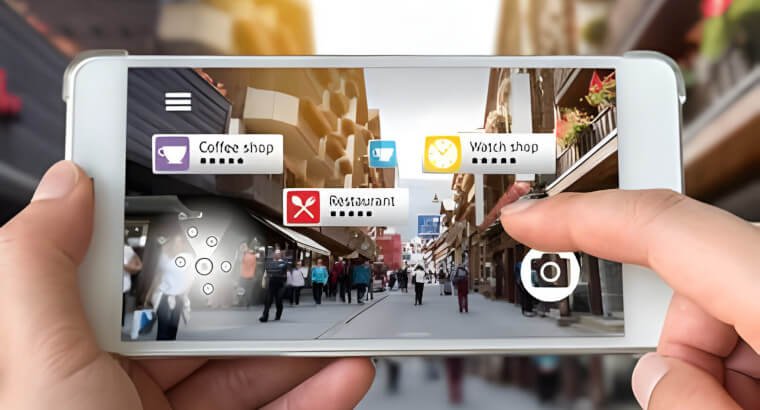
Ah, mobile marketing…📱 I remember the first time I tried to understand the nuances of this rapidly evolving field. A decade ago, I was at a beach holiday with my best mate Jerry, and he was raving about this new mobile app that allowed businesses to send push notifications. Fast forward to today, and my, how things have evolved! With the constant evolution of technology, mobile marketing has transformed itself beyond our wildest dreams. It’s not just about simple push notifications anymore; it’s about creating a unique and personalised user experience. I can still smell the sea salt in the air as we debated the Future of Mobile Marketing.
Evolution of mobile marketing.
Mobile marketing, huh? Well, it’s a bit like watching your favourite band grow up. At first, they’re playing at tiny venues, and then suddenly, they’re headlining the biggest festivals. I still remember when it all started with SMS campaigns. Remember the old Nokia phones and those promotional texts? Those were the early days of mobile marketing and mate, we’ve come a long way!
From there, we saw the advent of mobile apps, and who could forget the excitement around the App Store’s launch? Suddenly, everyone and their nan wanted to build an app! That, coupled with the rise of mobile advertising platforms like Google AdMob, changed the game. Mobile browsing took off next, making websites optimise for mobile users – and let’s not even get started on the surge of location-based promotions! My mother-in-law once got a sweet discount at her local bakery simply by walking past it with her Bluetooth on. Mad, right?🍰
Staying updated with the latest mobile marketing trends
Now, here’s a thing – why’s it so really important to keep up with mobile marketing trends, anyway? Remember Betamax? If you were placing your bets on that horse in the 80’s, you’d have lost a lot. The same goes for mobile marketing. Today’s cutting-edge strategy might be tomorrow’s dud. By staying updated, you’re ensuring you’re not left behind while everyone else zips ahead.
Being on top of trends is more than just knowing what’s ‘in’. It’s about staying relevant. Customers these days are savvy – trust me, my teenage niece knows more about mobile tech than I did in my 30s! If you’re not delivering the experiences they’re after, someone else will. And, as the saying goes, “If you’re not moving forward, you’re moving backward.” Or was it “if you’re not first, you’re last”? Either way, you get the drift!
Basics of Mobile Marketing
So, before we dive into the nitty-gritty, let’s revisit what mobile marketing is. I know, I know, this might sound basic for some of you seasoned marketers out there, but bear with me. It’s always good to revisit the fundamentals, right?
What is mobile marketing?
In essence, mobile marketing is about reaching your target audience on their mobile devices – smartphones, tablets, you name it. It includes tactics like SMS marketing, app-based marketing, mobile search ads, and the like. The primary goal? Drive engagement, conversions, and brand loyalty. And, of course, there’s the beauty of location-based marketing. Ever got a discount coupon when you’re near a shop? Yep, that’s mobile marketing at work.
But it’s not just about pushing ads. Nah, mate, it’s about creating meaningful connections. For example, I was once at a concert and got a notification for a free drink because I had the venue’s app. Now that’s a fan experience! 🍻
Why is it essential for businesses today?
Okay, hands up – who doesn’t have a mobile phone within arm’s reach right now? Thought so. With nearly everyone glued to their screens, it’s no wonder businesses are focusing their marketing efforts on mobile. And it’s not just about reaching people. It’s about reaching them in a personal, intimate space – their phones.
Mobile allows for tailored marketing like never before. Imagine getting a message about a new album just because you’d searched for that artist last week. Or an offer on a new novel because you’d bought books by the same author before. Businesses can engage customers on a level that was previously unheard of.
Key mobile marketing strategies that have been used historically
Ah, a trip down memory lane. From the golden age of SMS marketing (those were the days, eh?) to the dawn of mobile apps, mobile marketing has seen some serious shifts. And let’s not forget QR codes! Though many laughed them off initially, look how they’ve made a comeback during the pandemic. Cheers to safe dining and QR coded menus!🍷
Mobile ads, especially video ads, were a game-changer too. Brands could now tell stories in seconds, capturing hearts (and wallets). And who could forget the excitement around the first interactive mobile ads? Blimey, it felt like the future! The key through all these strategies was engagement – making the user feel a part of the brand’s story.
The Current Mobile Marketing Landscape
Now, let’s get a bit more up-to-date, shall we? Mobile marketing today is like a chameleon, constantly changing and adapting. Let’s dig in a bit, eh?
Dominant platforms and channels
Well, where do I begin? We’ve got the usual suspects – Google and Facebook leading the charge with their mobile ad platforms. But there’s also the rise of TikTok, a platform that many (myself included) underestimated initially. Who’d have thought watching folks dance for 15 seconds would revolutionise marketing?
And then there’s Instagram. With its shopping features, it’s turned into a goldmine for businesses. Not to mention, messaging platforms like WhatsApp and Messenger are fast becoming key players in the marketing game. Remember the time my sister sold her handmade scarves via WhatsApp stories? Good times!
Recent shifts in mobile user behaviour
Ah, the ever-evolving mobile user. Remember when apps were all the rage? Now, it seems people prefer using mobile sites as they’re not too keen on downloading yet another app (I mean, who has the storage space, right?). There’s also a shift towards voice search. I sometimes find myself asking my phone for the nearest pizza place rather than typing it out. Lazy? Maybe. Convenient? Hell yeah! 🍕
The line between online and offline is blurring. People are using their mobiles in stores, comparing prices, reading reviews, or even scanning QR codes for additional information. And the cherry on top? The rise of AR (Augmented Reality) experiences. Tried those AR try-ons for glasses? Absolute game-changer!
Mobile marketing metrics
Here’s where we dive a bit into the geeky stuff. Metrics. Now, it ain’t just about clicks and impressions anymore. Nah, mate, it’s evolved way beyond that. We’re looking at user engagement, app retention rates, lifetime value of a customer, and so much more. And it’s not just about numbers. It’s about understanding user behaviour. Why did they drop off at a particular stage? What led them to make a purchase? It’s a bit like playing detective, and I’m all here for it! 🕵️♂️
Technological Advancements Shaping Mobile Marketing
Ready to look a bit into the crystal ball? Let’s see how technology is shaping the future of mobile marketing. Exciting times ahead, folks!
Augmented Reality (AR)

I must say, the first time I tried an AR app, I was blown away. AR isn’t just for gaming anymore; it’s weaving its way into mobile marketing in a big way. Retailers are offering AR try-ons, tourism boards are providing AR experiences of attractions, and brands are creating interactive AR campaigns that engage and mesmerise. The possibilities? Endless. The challenge? Creating AR experiences that add value rather than being just a flashy gimmick.
5G technology and faster mobile internet: What does it mean?
5G is more than just a buzzword; it’s the next big leap in mobile connectivity. And with great speed comes…well, a lot of possibilities. Think about it – faster downloads, seamless streaming, real-time data processing. This could revolutionise mobile marketing, offering richer media experiences and even more precise location-based services. But, like all power, it comes with responsibility. How will brands use this without overwhelming the user? Only time will tell.
Rise of chatbots and AI-driven customer interactions
“Hello, how may I assist you today?” No, that’s not just a friendly customer rep; it’s a chatbot. These AI-driven interactions are becoming the norm, guiding users, answering queries, and even making sales. It’s a bit surreal thinking of how much of our online interactions are with machines, but hey, if it’s efficient and feels human, why not? Just gotta make sure it doesn’t turn all ‘Skynet’ on us, eh? 😜
Emerging Mobile Marketing Trends
Hang tight, we’re about to delve into what the future holds. I must say, it’s quite a thrilling ride!
Personalisation at scale: Tailoring experiences for individual users
It’s no longer enough to just address the user by their first name. Nah, personalization today is about curating experiences tailored to individual preferences, browsing history, and even moods. Brands are striving to make every user feel like they’re the only one. And with big data and AI, this is more achievable than ever. But remember, with great data comes great responsibility (see what I did there?). Brands must ensure they’re not crossing the line and becoming too invasive.
Video content
Now, here’s a pickle – short snappy videos or longer, more in-depth ones? With platforms like TikTok, short videos have seen a massive surge in popularity. But does that mean long-form content is dead? I think there’s room for both. Sometimes, you just wanna see a quick recipe, and other times, you’re in the mood for a 30-minute cooking show. The key is understanding your audience and delivering what they crave.
Voice search
“Hey, where’s the nearest coffee shop?” Voice search is on the rise, and it’s changing the game for mobile marketers. It’s not just about text-based search keywords anymore. Brands need to understand voice search intent and optimise accordingly. And with smart speakers becoming a staple in homes, there’s a whole new avenue for advertising. Picture this: asking your smart speaker for a brownie recipe and getting a suggestion to order some from a nearby bakery. Tempting, eh?
The Role of Data in Future Mobile Marketing
Ah, data, is the backbone of modern marketing. But it’s not just about collecting numbers; it’s about making sense of them.
The rise of big data and analytics
Every swipe, click, and scroll generates data. And with advancements in tech, we can process and analyse this data like never before. This isn’t just for showing fancy charts in board meetings (though, I admit, it’s a bit fun to show off). It’s about understanding user behaviour, predicting trends, and tailoring strategies. But, as Uncle Ben once said, “With great power comes great responsibility.” Using this data ethically is paramount.
Privacy concerns and data regulation (e.g., GDPR, CCPA)
With the collection of data comes the inevitable debate on privacy. Users are becoming more aware of their digital footprints and are demanding transparency. Regulations like GDPR and CCPA are making sure businesses respect this right to privacy. And while it might seem like a hassle to comply, in the long run, it builds trust. After all, no one likes feeling like they’re constantly being watched, right?
Predictive analytics and forecasting user behavior
Imagine being able to predict what a user wants even before they know it. No, it’s not mind reading; it’s predictive analytics. By analysing user behaviour, past purchases, and other metrics, brands can forecast future actions. This is a game-changer, allowing for proactive marketing. But there’s a fine line between helpful and creepy, and brands need to tread carefully.
Challenges Ahead for Mobile Marketers
It’s not all sunshine and rainbows. With innovation come challenges. Let’s dive into some of the hurdles ahead, shall we?
Ad-blocking technologies
Ah, ad-blockers, the bane of every marketer’s existence. With users becoming wary of intrusive ads, the popularity of ad-blockers has skyrocketed. This means marketers need to get more creative – think native advertising, influencer partnerships, and quality content marketing.
Cross-platform and cross-device tracking issues
With users hopping from one device to another, tracking has become a bit of a nightmare. How do you ensure consistent messaging across devices? How do you attribute conversions? It’s like trying to juggle while riding a unicycle – tricky but not impossible.
To effectively manage cross-platform and cross-device tracking, advertisers must adopt a multi-faceted strategy. First of all, the utilization of universal tracking technologies becomes essential. These technologies work by assigning a unique identifier to each user, enabling trackers to follow the user’s journey across different devices and platforms seamlessly. This approach ensures that messaging stays consistent, avoiding repetition or message fatigue.
Moreover, employing advanced analytics tools is crucial for accurate conversion attribution. By leveraging machine learning algorithms and data modelling techniques, it’s possible to analyze complex patterns of user behaviour across platforms and devices accurately. These insights allow marketers to attribute conversions more precisely and understand the impact of various touchpoints on the consumer’s decision-making process.
Integration with Customer Relationship Management (CRM) systems further enriches this ecosystem by providing a comprehensive view of each customer’s interactions with your brand. Through CRM integration, marketers can achieve true personalization at scale – tailoring messages based not just on where users are interacting but also taking into account their history with your brand.
Another effective solution is adopting a mobile-first approach in marketing strategies since most users primary device is now a smartphone or tablet. Building campaigns with mobile as the starting point ensures that experiences are optimized for smaller screens first before adapting them for desktop environments. This mindset shift guarantees better performance across devices because it addresses one of the fastest-growing segments directly from its core.
Lastly but importantly, transparency and respecting privacy regulations play an essential role in cross-device tracking efforts’ success. With increasing scrutiny around data usage and privacy concerns (e.g., GDPR in Europe), ensuring open communication about how data is collected and used builds trust between consumers and brands. Being upfront about privacy encourages opt-ins which ultimately lead to richer datasets available for analysis without compromising individual privacy rights.
Authentic and genuine brand storytelling in an era of distrust
Let’s face it, folks are getting a tad sceptical about brands. They want authenticity, stories that resonate, and genuine engagement. No more hard selling; it’s time for heartfelt storytelling. Remember, people connect with people, not faceless corporations.
This paradigm shift towards authentic engagement underscores the importance of humanizing your brand. In today’s digital age, where consumers are bombarded with ads and corporate jargon, the brands that stand out are those who dare to be different – showing their true colours, vulnerabilities, and even failures. It’s about creating a narrative that goes beyond products or services; it’s about building connections on shared values and experiences.
Moreover, embracing transparency is key. Openly sharing behind-the-scenes content, acknowledging mistakes when they happen and how you’re addressing them not only cultivates trust but also fosters loyalty among customers. This approach can turn casual consumers into brand advocates who believe in what you do and why you do it.
Integrating user-generated content (UGC) is another strategy to bolster authenticity while engaging directly with your audience. Encouraging customers to share their own stories relating to your brand not only provides social proof but also deepens the emotional connection other potential customers may feel towards your company. UGC acts as a multi-faceted tool that amplifies voice-of-customer insights while enhancing credibility through real-life testimonials.
But being genuine doesn’t stop at storytelling; it must permeate every aspect of your digital marketing efforts from personalized email campaigns to interactive social media posts which invite conversation rather than broadcast messages. Making use of data analytics tools can help tailor these interactions more closely to individual needs and preferences without losing sight of privacy concerns—a balancing act that respects the customer’s space while providing value.
Strategies to Stay Ahead
Alright, champs, let’s arm ourselves for the future with some top-notch strategies.
Continual learning and adaptability
The digital world is ever-evolving, and if you’re not learning, you’re falling behind. Whether it’s taking up a course, attending webinars, or just staying updated with industry news – keep that brain of yours sharp and agile.
Investing in tools and technologies for better data-driven decisions
Don’t be penny-wise and pound-foolish. Investing in the right tools can make data collection, analysis, and mobile marketing strategy implementation a breeze. After all, why do manually what a tool can do in seconds?
Moreover, embracing social media platforms and influencer partnerships extends the reach of authentic brand messages, transforming customers into a motivated sales force. The power of human connection cannot be underestimated in this digital age. Therefore, brands that prioritize meaningful engagement over spamming their audiences with ads are the ones that will stand out.
Build a brand community for direct communication
Why rely on third-party platforms when you can build your own community? Think newsletters, forums, and exclusive member portals. It’s like hosting your own party rather than gatecrashing someone else’s.
Future of Mobile Marketing: Ending Thoughts
Phew! What a roller-coaster of insights and revelations. Mobile marketing is no longer an option; it’s a necessity. And with the rapid pace of tech advancements, staying updated isn’t just a nice-to-have – it’s survival.
To all you marketers out there – never rest on your laurels. Experiment, learn, iterate. The digital world rewards the brave and the curious.
Overall, mobile marketing is an exhilarating space. From the rise of AR and 5G to the ever-present challenge of ad-blockers, there’s never a dull moment. I’ve had my share of highs and lows in this space, and trust me, the learning never stops.
Finally, a big thank you for sticking with me through this deep dive. Remember, the future belongs to those who prepare for it today. Keep rocking the digital space and, as always, keep it groovy! ✌️


